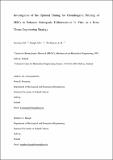Investigation of the optimal timing for chondrogenic priming of MSCs to enhance osteogenic differentiation in vitro as a bone tissue engineering strategy
Date
2013-08-07Author
Freeman, Fiona E.
Haugh, Matthew G.
McNamara, Laoise M.
Metadata
Show full item recordUsage
This item's downloads: 469 (view details)
Cited 17 times in Scopus (view citations)
Recommended Citation
Freeman, F. E., Haugh, M. G., and McNamara, L. M. (2016) Investigation of the optimal timing for chondrogenic priming of MSCs to enhance osteogenic differentiation in vitro as a bone tissue engineering strategy. J Tissue Eng Regen Med, 10: E250–E262. doi: 10.1002/term.1793.
Published Version
Abstract
Recent in vitro tissue engineering approaches have shown that
chondrogenic priming of human bone marrow mesenchymal stem cells (MSCs)
can have a positive effect on osteogenesis in vivo. However, whether
chondrogenic priming is an effective in vitro bone regeneration strategy
is not yet known. In particular, the appropriate timing for
chondrogenic priming in vitro is unknown albeit that in vivo cartilage
formation persists for a specific period before bone formation. The
objective of this study is to determine the optimum time for
chondrogenic priming of MSCs to enhance osteogenic differentiation by
MSCs in vitro. Pellets derived from murine and human MSCs were cultured
in six different media groups: two control groups (chondrogenic and
osteogenic) and four chondrogenic priming groups (10, 14, 21 and 28 days
priming). Biochemical analyses (Hoechst, sulfate glycosaminoglycan
(sGAG), Alkaline Phosphate (ALP), calcium), histology (Alcian Blue,
Alizarin Red) and immunohistochemistry (collagen types I, II and X) were
performed on the samples at specific times. Our results show that after
49 days the highest amount of sGAG production occurred in MSCs
chondrogenically primed for 21 days and 28 days. Moreover we found that
chondrogenic priming of MSCs in vitro for specific amounts of time
(14 days, 21 days) can have optimum influence on their mineralization
capacity and can produce a construct that is mineralized throughout the
core. Determining the optimum time for chondrogenic priming to enhance
osteogenic differentiation in vitro provides information that might lead
to a novel regenerative treatment for large bone defects, as well as
addressing the major limitation of core degradation and construct
failure.


